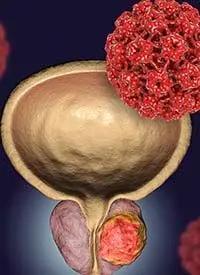Article
Expert explains everything you need to know about lutetium Lu-177 vipivotide tetraxetan for mCRPC
Author(s):
177Lu-PSMA-617 is a radiopharmaceutical that is recommended to be handled with appropriate safety measures to minimize radiation exposure.

Earlier this year, the FDA approved lutetium Lu-177 vipivotide tetraxetan (Pluvicto; Novartis), which is referred to in nuclear medicine literature as 177Lu–prostate-specific membrane antigen–617 (177Lu PSMA-617), for the treatment of PSMA-positive metastatic castration resistant prostate cancer (mCRPC).1 Eligibility for treatment with 177Lu-PSMA-617 for patients is based on whether they had previously been treated with at least 1 prior androgen receptor pathway inhibitor or with 1 to 2 prior taxane regimens.2
PSMA-positive disease is defined as at least 1 PSMA-positive metastatic lesion and no PSMA-negative lesions, determined with the FDA-approved gallium Ga 68 gozetotide injection (Locametz; Novartis), which is a radioactive diagnostic agent for PET imaging of PSMA-positive lesions, or another approved PSMA-11 imaging agent.2 In men with previously treated PSMA-positive mCRPC, the randomized (2:1), multicenter, open-label VISION trial (NCT03511664) evaluated 177Lu PSMA-617 in combination with best standard of care (BSoC) (n = 551) against BSoC alone (n = 280). BSoC included abiraterone, enzalutamide, bisphosphonates, local radiation therapy, denosumab, and/or glucocorticoids. Patients were not permitted to receive cytotoxic chemotherapy, systemic radioisotopes, or immunotherapy in combination with 177Lu-PSMA-617.3
Based on the results of the trial, investigators observed 177Lu-PSMA 617 plus BSoC improved median overall survival (OS) and progression free survival (PFS) compared with BSoC alone. Median OS was 15.3 months in the 177Lu-PSMA-617 group compared with 11.3 months in the control group (HR for death, 0.62; 95% CI, 0.52-0.74; P < .001). Median PFS was 8.7 months in the 177Lu-PSMA-617 group compared with 3.4 months in the control group (HR for progression or death, 0.40; 99.2% CI, 0.29-0.57; P < .001).3
Mechanism of Action
177Lu-PSMA-617 is a radioligand therapeutic agent, with the radionuclide lutetium-177 linked to a moiety that binds to PSMA, which is a transmembrane protein expressed in prostate cancer. Upon binding to PSMA-expressing cells, the beta-minus emission from lutetium-177 delivers radiation to PSMA-expressing cells, which induces DNA damage and can lead tocell death.2
Dosage and Administration
177Lu-PSMA-617 is dosed at 7.4 GBq (200 mCi) intravenously every 6 weeks for up to 6 treatments, or until disease progression or unacceptable toxicity. Before administration with 177Lu-PSMA-617, patients’ vital signs should be collected 15 minutes prior, as well as 30 and 60 minutes after administration.2
177Lu-PSMA-617 is a radiopharmaceutical that is recommended to be handled with appropriate safety measures to minimize radiation exposure. 177Lu-PSMA-617 may be administered intravenously (1-10 minutes) using a disposable syringe fitted with a syringe shield (with or without a syringe pump), as an infusion pump using the gravity method (with or without an infusion pump), or as an infusion using the vial (with a peristaltic infusion pump).2
Adverse Events
For patients who received 177Lu-PSMA-617, the most common adverse events (AEs) they noted included fatigue, dry mouth, nausea, anemia, decreased appetite, and constipation. During the trial, 177Lu-PSMA-617 was discontinued in 12% of patients due to any treatment-related AEs. In less than 5% of patients, clinically relevant AEs included dry eye, vertigo, and pancytopenia (including bicytopenia).2
Warnings and Precautions
177Lu-PSMA-617 has labeled warnings for risk of radiation exposure, bone marrow suppression, renal toxicity, embryo-fetal toxicity, and infertility. As a targeted radiopharmaceutical, 177Lu-PSMA-617 contributes to a patient’s cumulative radiation exposure. In accordance with institutional good radiation safety practices and Nuclear Regulatory Commission patient-release guid-ance, it is important to minimize radiation exposure to patients, health care personnel, and household contacts.
During treatment with 177Lu-PSMA-617, patients should be counseled to increase oral fluid intake and to void frequently to reduce bladder radiation exposure. Following administration of 177Lu-PSMA-617, patients also must limit close contact (< 3 ft) with household contacts for 2 days or with children and pregnant women for 7 days. Patients must also refrain from sexual activity for 7 days. Patients should sleep in a separate bedroom from household contacts for 3 days, from children for 7 days, or from pregnant women for 15 days.2
177Lu-PSMA-617 may cause severe and life-threatening myelosuppression. In the manufacturer’s labeling, grade 3 to 4 anemia was experienced among 13% of patients, grade 3 to 4 neutropenia in 5% of patients, grade 3 to 4 thrombocytopenia in 8% of patients, and grade 3 to 4 lymphocytopenia in 47% of patients. Complete blood counts should be obtained before each treatment with 177Lu-PSMA-617. Withhold, dose reduce, or discontinue 177Lu-PSMA-617 based on the grade of myelosuppression experienced.2
177Lu-PSMA-617 can also cause severe renal toxicity. During the trial, 3% of patients experienced grade 3 to 4 acute kidney injury. Because of this, patients should be counseled to remain well hydrated. Additionally, patients’ serum creatinine and calculate creatinine clearance should be monitored before each treatment with 177Lu-PSMA-617.2
Furthermore, because 177Lu-PSMA-617 is absorbed into the testes, the recommended cumulative dose of 44.4 GBq of 177Lu-PSMA-617 results in a radiation absorbed within the range where 177Lu-PSMA-617 may cause temporary or permanent infertility.2
In women, the safety and efficacy of 177Lu-PSMA-617 have not been established. All radiopharmaceuticals, including 177Lu-PSMA-617, have the potential to cause fetal harm. For male patients with female partners of reproductive potential, patients should be advised to use effective contraception during treatment with 177Lu-PSMA-617 and for 14 weeks after the last dose.2
About the Author
Stephanie Trexler, PharmD, BCOP, is a clinical oncology pharmacist at the Smilow Cancer Hospital and Yale New Haven Health in Connecticut.
References
1. FDA approves Pluvicto for metastatic castration-resistant pros-tate cancer. FDA. Updated March 23, 2022. Accessed September 15, 2022. https://www.fda.gov/drugs/resources-information-approved-drugs/fda-approves-pluvicto-metastatic-castration-resistant-prostate-cancer
2. Pluvicto. Prescribing information. Novartis Pharmaceuticals Corp; 2022. Accessed September 10, 2022. https://www.accessdata.fda.gov/drugsatfda_docs/label/2022/215833s000lbl.pdf
3. Sartor O, de Bono J, Chi KN, et al. Lutetium-177-PSMA-617 for metastatic castration-resistant prostate cancer. N Engl J Med. 2021;385(12):1091-1103. doi:10.1056/NEJMoa2107322















